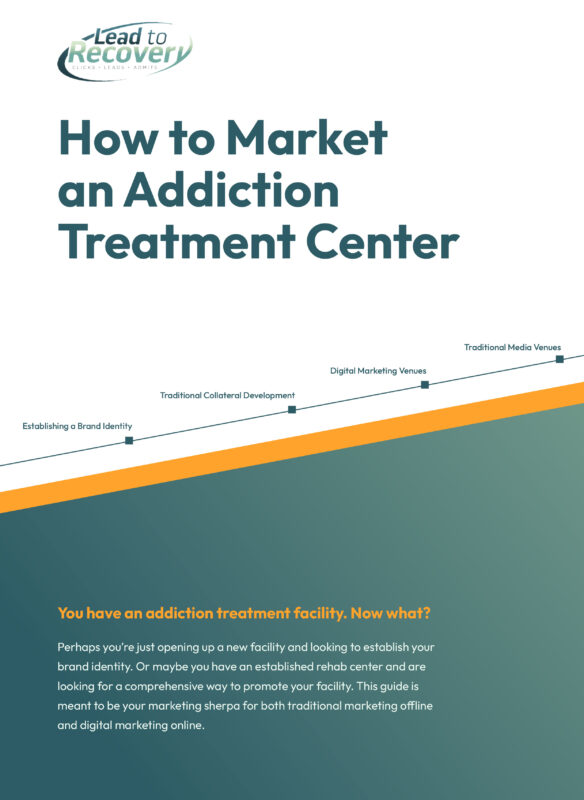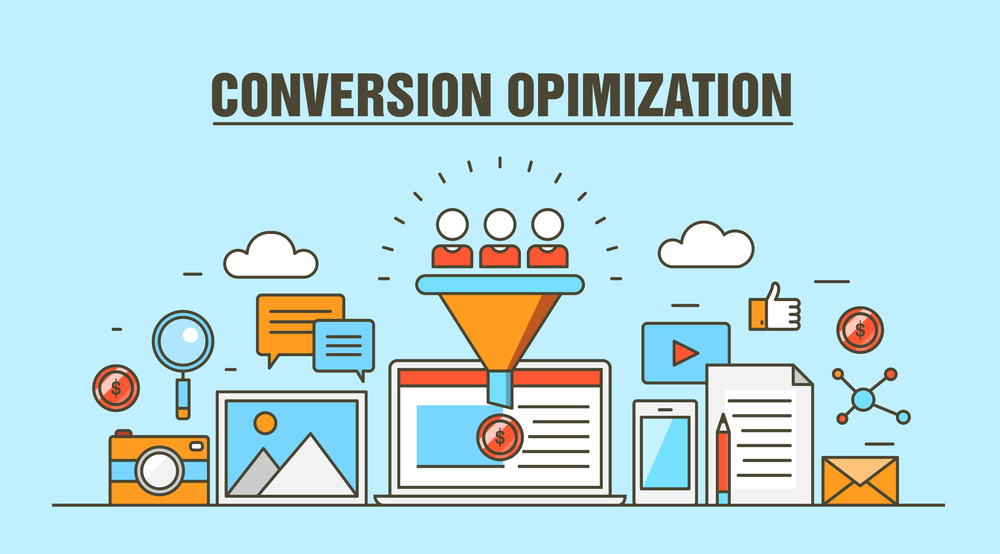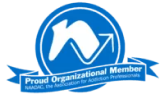In the competitive world of healthcare and rehabilitation services, having a well-designed website is just the beginning. To truly make an impact and drive business growth, it’s essential to increase your rehab website’s conversion rate. Effective strategies and best practices for conversion rate optimization (CRO) to ensure your rehab center’s website converts visitors into patients include website design, high-quality content creation, building trust, and partnering with a leading rehab digital marketing agency that provides rehab CRO services. In this blog, we discuss each essential element of conversion rate optimization for rehab websites.

LEAD TO RECOVErY
The Definitive Marketing Guide to Full Admissions
You opened a treatment center. Now what?
Perhaps you’re just opening up a new center and looking to establish your brand identity. Or maybe you have an established center and are looking for a comprehensive way to promote your facility.
Understanding Conversion Rates
Before diving into the strategies, let’s clarify what conversion rates mean. In the context of a rehab center’s website, a conversion happens when a site visitor takes a desired action, such as filling out a contact form, signing up for a newsletter, or booking an appointment. A high conversion rate indicates that your website effectively meets the needs of your target audience and encourages them to take the next step in their patient journey.
Optimize Website Design for Conversions
A user-friendly website is crucial for increasing conversion rates. Here’s how to ensure your rehab center’s website design supports a successful CRO strategy:
User-Friendly Navigation
Simplify navigation to help visitors easily find the information they need. Clear menus and logical site structure can reduce bounce rates and keep visitors engaged. Here are some specific strategies:
- Intuitive Menus: Use drop-down menus to organize content hierarchically, allowing users to drill down into more specific topics.
- Breadcrumb Navigation: Implement breadcrumb trails to help users understand their location within the site and easily backtrack.
- Search Functionality: Provide a robust search feature to help users quickly find specific information.
- Consistent Layout: Keep navigation elements consistent across all pages to provide a predictable and seamless user experience.
Responsive Design
With more users accessing websites via mobile devices, ensuring your site is mobile-friendly is essential. A responsive design enhances user experience, which can lead to higher conversion rates. Key considerations include:
- Flexible Layouts: Use fluid grids and flexible images that adjust to different screen sizes and orientations.
- Touch-Friendly Elements: Ensure buttons and links are large enough to be easily tapped on small screens.
- Fast Load Times: Optimize images and use efficient coding practices to ensure quick load times on mobile networks.
- Cross-Browser Compatibility: Test your website on various browsers and devices to ensure a consistent experience.
Visual Appeal
An aesthetically pleasing website can make a strong first impression. Use high-quality images, clean layouts, and consistent branding to keep visitors engaged and encourage them to explore further. Here’s how to enhance visual appeal:
- High-Quality Images: Use professional photography or high-resolution images to convey professionalism and quality.
- Clean Design: Avoid cluttered layouts. Use white space effectively to make content stand out and improve readability.
- Consistent Branding: Use consistent colors, fonts, and branding elements throughout your site to build brand recognition and trust.
- Engaging Multimedia: Incorporate videos, infographics, and other multimedia elements to make your content more engaging.
Create Helpful Content for Successful Conversion Rate Optimization
Effective content creation is at the heart of any successful CRO strategy. Here’s how to leverage content marketing for your rehab to boost conversion rates:
High-Quality, Relevant Content
Provide valuable information that addresses the pain points of your potential clients. Blog posts, informative articles, and detailed service descriptions can establish your authority and build trust with your audience. Key strategies include:
- Educational Content: Create blog posts and articles that educate your audience about addiction, treatment options, and recovery processes.
- Detailed Service Pages: Offer comprehensive descriptions of the services you provide, including the benefits and unique aspects of your rehab center.
- Case Studies: Share real-life success stories to demonstrate the effectiveness of your treatments and humanize your brand.
Clear and Compelling CTAs
Calls-to-action (CTAs) should be clear and compelling. Use action-oriented language and place CTAs strategically throughout your site to guide visitors through the conversion funnel. Effective CTAs include:
- Prominent Placement: Position CTAs in high-visibility areas such as headers, footers, and within content.
- Action-Oriented Language: Use verbs like “Get Help Now,” “Contact Us Today,” or “Schedule a Consultation” to prompt immediate action.
- Visual Contrast: Make your CTAs stand out using contrasting colors and bold fonts.
SEO Best Practices
Search engine optimization (SEO) is crucial for driving targeted traffic to your website. Use relevant keywords, optimize meta tags, and create content that addresses common search queries related to rehab services. Here are some tips for rehab SEO:
- Keyword Research: Identify and use keywords your target audience will likely search for, including long-tail keywords specific to rehab services.
- On-Page SEO: Optimize title tags, meta descriptions, headers, and image alt texts with relevant keywords.
- Content Quality: Ensure your content is informative, well-written, and regularly updated to improve search engine rankings.
- Internal Linking: Use internal links to connect related content and improve site navigation.

Optimize your website with advanced SEO techniques by schedule a consultation with our experts today.
Build Trust and Credibility to Increase Conversions
Trust is a significant factor in conversion rate optimization. Here are ways to build credibility:
Client Testimonials and Positive Reviews
Featuring client testimonials and positive reviews can significantly enhance trust. Highlighting success stories and experiences from previous patients can reassure potential clients about the quality of your services. Effective practices include:
- Dedicated Testimonial Page: Create a dedicated page for client testimonials to showcase positive experiences and outcomes.
- Video Testimonials: Use testimonials to provide a more personal and convincing portrayal of success stories.
- Third-Party Reviews: Highlight reviews from third-party sites like Google My Business and Yelp to add credibility.
Certifications and Accreditations
Display relevant certifications and accreditations prominently on your website. This can help establish your rehab center as a credible and trustworthy provider. Tips include:
- Visible Badges: Place certification badges in prominent locations such as the header, footer, or about page.
- Detailed Information: Explain what each certification means and why it’s important.
Transparency
Be transparent about your services, pricing, and success rates. Transparency can foster trust and encourage potential clients to take action. Key strategies include:
- Clear Service Descriptions: Provide detailed information about what each service entails, including the steps involved and the expected outcomes.
- Pricing Information: Offer clear and upfront pricing information, including any financing or insurance options available.
- Success Metrics: Share statistics and success rates to demonstrate the effectiveness of your treatments.
Focusing on these areas can effectively engage visitors, build trust, and ultimately increase conversion rates on your rehab center’s website. Partnering with Lead to Recovery can further enhance your conversion rate optimization efforts, helping you attract and convert qualified leads.

LEAD TO RECOVErY
The Definitive Marketing Guide to Full Admissions
You opened a treatment center. Now what?
Perhaps you’re just opening up a new center and looking to establish your brand identity. Or maybe you have an established center and are looking for a comprehensive way to promote your facility.
Enhance User Engagement
Keeping visitors engaged is key to conversion optimization. An engaged visitor is more likely to take the desired action, whether signing up for a newsletter, filling out a contact form, or scheduling an appointment. Here’s how to enhance user engagement on your rehab center’s website:
Interactive Elements
Incorporating interactive elements can significantly improve user experience and increase the likelihood of conversion. Here are some effective interactive elements:
- Chatbots: Implementing chatbots can provide immediate responses to visitor inquiries, guiding them through the patient journey and helping them quickly find the information they need. Chatbots can also collect visitor data, which can be used for follow-up marketing efforts.
- Quizzes: Interactive quizzes can engage visitors by offering personalized assessments or helping them better understand their needs. For example, a quiz on addiction severity or treatment options can provide valuable information and encourage visitors to seek further assistance.
- Interactive Forms: Dynamic forms that adapt based on user input can make seeking information or signing up more engaging and less daunting. These forms can also pre-qualify leads, ensuring that the inquiries you receive are from qualified leads.
Personalization
Tailoring the user experience based on visitor behavior and preferences can make visitors feel valued and more likely to engage with your services. Personalization can be achieved through:
- Behavioral Targeting: Use data on visitor behavior to present personalized content and offers. For instance, if a visitor has viewed multiple pages about detox programs, you can highlight related success stories or offer a free consultation specifically for detox services.
- Personalized Content: Show visitors content that matches their interests and previous interactions with your site. This could include blog posts, testimonials, or videos that align with their browsing history.
- Email Marketing: Personalized email campaigns can nurture leads and keep your rehab center top-of-mind for potential patients. Tailor your messages based on the recipient’s interaction with your site and previous communications.
Leverage Analytics
Data-driven decisions are essential for effective CRO efforts. By understanding how visitors interact with your site, you can make informed decisions to improve conversion rates. Here’s how to use analytics for higher conversion rates:
Tracking User Behavior
Using analytics tools to track visitor behavior provides insights into how users interact with your site. Key areas to monitor include:
- Heatmaps: Heatmap tools show where visitors click, scroll, and hover on your pages. This data can help you understand which elements are drawing attention and which areas may need optimization.
- Session Recordings: Session recordings allow you to watch real user sessions on your site. This can reveal pain points, such as where visitors abandon forms or which pages cause confusion.
- Funnel Analysis: Analyze the conversion funnel to see where visitors drop off in the process. Identifying these drop-off points can help you address specific issues and improve the overall user journey.
A/B Testing
A/B testing involves comparing two webpage versions to determine which performs better. This method can help you optimize various elements of your site for better engagement and conversions:
- Headlines: Test different headlines to see which one captures more attention and encourages users to stay on the page longer.
- Images: Experiment with different images to determine which visuals resonate most with your audience and drive engagement.
- CTAs: Test different calls-to-action (CTAs) to find the most effective wording, placement, and design. For example, you might test “Get Help Now” versus “Contact Us Today” to see which prompt leads to more conversions.
- Landing Pages: Create multiple versions of your landing pages to test different layouts, content, and offers. Determine which version generates more leads and qualified traffic.
By continually testing and refining your site elements, you can ensure that your CRO strategy is effective and aligned with the needs and preferences of your target audience.
Partner with Lead to Recovery for Enhanced Conversions
Increasing your rehab center’s conversion rates requires a holistic approach that combines design, content, trust-building, and analytics. Implementing these strategies can enhance your website’s effectiveness and convert more visitors into patients.
Partner with Lead to Recovery for expert assistance in conversion rate optimization. Our comprehensive digital marketing services for rehabs are designed to help rehab centers achieve higher conversion rates and attract qualified leads. Contact us today to learn more about how we can support your CRO strategy and help your rehab center grow.

Content written by rehab marketing expert Matthew Travers
Co-Founder
Matthew Travers is a seasoned Digital Marketing Professional with a distinguished career spanning 21 years, dedicating the last decade to the specialized fields of addiction treatment and mental health marketing. He brings a deep passion for creating powerful marketing strategies, with a distinctive proficiency in SEO and conversion rate optimization, aligning business objectives with innovative solutions to drive success.


